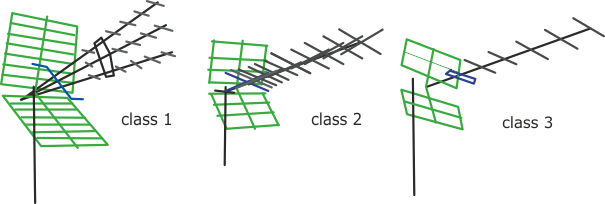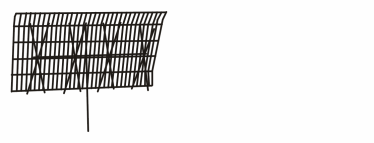Freeview reception - all about aerials
 Brian Butterworth published on UK Free TV
Brian Butterworth published on UK Free TV Updated 8th January 2014.
Your ability of receive all the Freeview transmissions depends on the suitability of aerial
- the design style,
- the "group", and
- its physical location.
Standard type - Yagi aerial

The standard type of TV aerial is known as the Yagi aerial. It is mounted on a pole, and consists of a rod with a reflector (shown green) at the back and many spiky elements (in grey) at the front. The connecting cable connects to the element nearest the reflector, known as the driver (shown in blue).
These Yagi aerials are directional and so pick up signals best from a transmitter that the rod points towards. The more elements the aerial has, the better it picks up a signal and becomes more directional.
A standard-type aerial is all that is required for digital TV reception in most places. These antennae have between 10 and 18 elements and a single reflector. These are recommended for new installations for good digital television reception, but will more often than not function perfectly in good reception areas.
Typically these aerials are designed to receive only some transmission frequencies - see "groups" below.
High Gain aerials

These aerials are designed for poor digital reception areas, and have two reflectors. For maximum signal strength, some digital high gain aerials have up to 100 elements. Since the switchover to digital-only transmissions back in October 2012, most UK households now have good quality digital TV signals.
A more expensive aerial is only required where the signal strength is low, but can often provide the whole Freeview reception where it might otherwise be impossible.
The CAI (that represents aerial installers) has four standards for digital TV aerials. The highest standard "1" is for homes on the fringes of coverage areas, intermediate standard "2" is suitable for use within the coverage area; minimum standard "3" is for good coverage conditions.
These aerials can be either wideband, or receive only selected frequencies - see "groups" below.
Grid

You may haved used a 'Grid aerial' for analogue reception, but as they are generally unsuitable for Freeview reception, they have now generally been replaced by the Yagi type. However in some places a Grid aerial installation may work for Freeview: otherwise replace with a standard Yagi aerial.
Indoor
Indoor aerials are generally not suitable for Freeview reception. In areas of good signal strength it is often possible to receive some transmissions. Even where an aerial works, people often find that may get interruptions to their viewing (or recording).Loft mounted
Loft mounted arrivals are not generally recommended for Freeview reception, as the roof tiles and plumbing will degrade the signal. Some compensation for this loss of signal can be made by using satellite-grade cable to connect the set top box to the aerial.Positioning
The best position for a TV aerial is mounted outdoors, as high from the ground as possible, pointing directly at the transmitter. The signal can be blocked by hills and tall buildings. It should be positioned away from any other aerials.Horizontal or vertical?
The transmitter will either use vertical mode which requires the elements of your aerial to be up-down, or horizontal mode which requires them to be level with the ground.Groups
Both analogue and digital television is transmitted the same group of transmission frequencies (known as channel 21 through to 60). A coloured marking on the aerial shows the group.
To create the best possible analogue picture, TV transmissions from adjacent transmitters have been designated to several different groups of frequencies. By using an aerial that receives only the channels in the correct group, the analogue picture can be kept free from interference.
To receive Freeview transmissions from the same transmitter it has been sometimes necessary to use frequencies that are not part of the transmitter's normal group. When this has occurred, the aerial will need to be replaced with a "wideband" aerial (also known as group W) - one that covers every group.
As Ofcom is planning to move the TV frequencies again - perhaps as soon as 2018 - it may be wise to use a wideband aerial if you can to ensure you can keep viewing Freeview for many years to come.
Help with Television sets?
Monday, 6 August 2018
Could you please tell me which is the best aerial I can buy (roof fitting) for reception from winterbourne stickland transmitter
(freeview). I live in Blandford Forum
Thanks
David Meek
| link to this comment |
MikeP
3:41 PM
3:41 PM
david Meek:
Please put your post code into the Digital UK Coverage Checker at Digital UK - Coverage checker and scroll down to the listing of available transmitters at your location. If there is an entry for Winterbourne Stickland it will tell you what aerial group is needed. Generally it is now advisable to fit a wideband type so it can provide reception of all current and future channels without any need to have it changed in future. Aerials that are designed for a specific group of channels may not be suitable in future.
| link to this comment |
Wednesday, 5 December 2018
Hi I have a lodge in Malton, North Yorkshire, the local news channel I receive Covers as far up as Berwick across to Cumbria and upto Newcastle. I find this odd as where I live in Halifax my local station covers Leeds, Bradford, York.
Malton being only 25 mins from York, and 35 from Leeds I would have expected news coverage to be more from around here rather than nearly 170 miles away.
I'm getting a new smart TV soon will that help or is it my aerial, and if so what can I do to receive more local news and weather.
Many thanks.
Kind regards.
Glenn Layfield
| link to this comment |
MikeP
10:54 PM
10:54 PM
Glenn Layfield :
It is a matter of which transmitter is providing services to the area around your Lodge. If you provide a full post code for that location we may be able to advise any possible alternatives.
The broadcasters agree with Ofcom and Arqiva which transmitters will broadcast their signals and regional services are carefully controlled so as not to interfere with other broadcasts - and they are strictly regional.
| link to this comment |
Monday, 25 March 2019
R
Roger C4:26 PM
what I need to do to convert my roof top TV receive antenna as UHF transmitter and receiver antenna?
At present the antennas are receive only and connected via 75 ohms coax.
Thank you for your help
| link to this comment |
S
StevensOnln15:28 PM
Roger C: What are you trying to transmit? An aerial is just a piece of metal, it doesn't know or care whether it is transmitter or receiving. It's down to the equipment it's connected to as to whether it is transmitting or receiving a signal.
| link to this comment |
MikeP
8:10 PM
8:10 PM
Roger C:
Further to that said by StevensOnln1, to operate a transmitter will require an authority to broadcast as nobody can just start to radiate RF signals without a licence or authority except in a very few specific instances - none of which could use a TV aerial.
| link to this comment |
Saturday, 15 June 2019
B
Brian4:49 PM
Penrith
I recently installed a Labgear SLx48 aeriel from Screwfix on top of the house. We are at Ca10 3RG. We never get than many channels becaus of the transmitor. The aeriel is mounted in a vertically orientation which the previous one was and so are the neighbours. When I do this I fail to get any of the BBC channels. The other channels, ITV, Channel 4 etc are OK. If I change to a horizontal orientation then I can receive BBC channels OK but not ITV etc. Any idea what is happening and how I can resolve this.
| link to this comment |
Brian's: ...
Sunday, 16 June 2019
J
js6:24 AM
Brian: The coverage checker shows Orton as your Most Likely Transmitter and Winter Hill as the sole Alternative Transmitter:
Coverage Checker - Detailed View
D3&4 is on UHF50 from Orton, as is BBCA from Winter Hill.
If you change the aerial orientation from Vertical to Horizontal you may lose D3&4 from Orton and find BBC A from Winter Hill in its stead.
That might explain your observations if you have been getting BBCA off UHF50.
With the aerial set vertically, you should get good reception of both BBCA on UHF43 and D3&4 on UHF50.
| link to this comment |
Tuesday, 18 June 2019
M
Michael Glaves11:54 PM
I've said this before but in your article there is no mention of the log periodic aerial which is becoming increasingly common where a wideband aerial is required.
| link to this comment |
Select more comments
Your comment please!